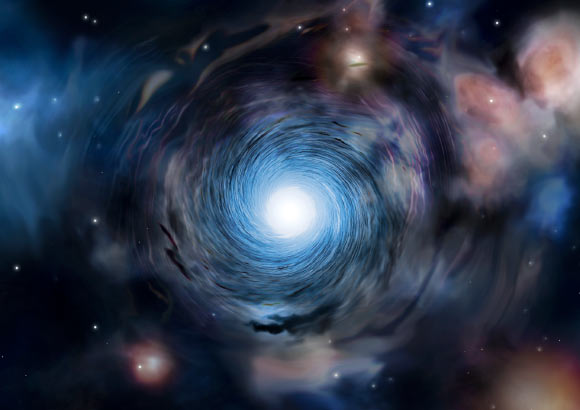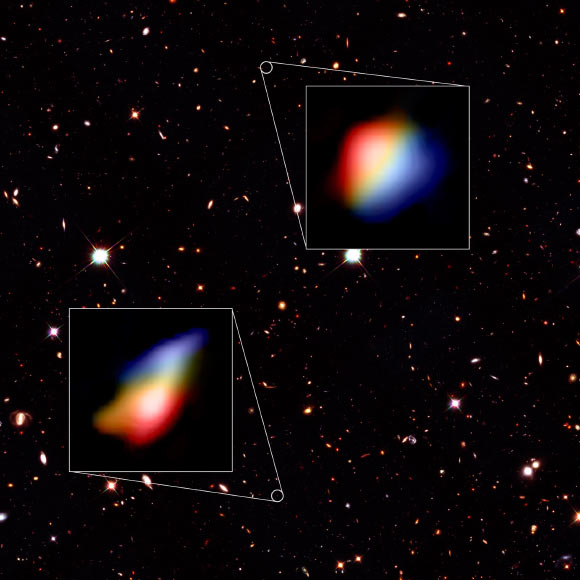Astronomers using the Atacama Large Millimeter/submillimeter Array (ALMA) in Chile have spotted swirling gas in some of the Universe’s earliest galaxies.

Artist’s impression of a galaxy in the early Universe. Image credit: Amanda Smith, University of Cambridge.
Light from distant objects takes time to reach Earth, so observing objects that are billions of light years away enables us to look back in time and directly observe the formation of the earliest galaxies.
The Universe at that time, however, was filled with an obscuring ‘haze’ of neutral hydrogen gas, which makes it difficult to see the formation of the very first galaxies with optical telescopes.
Dr. Renske Smit from the Kavli Institute of Cosmology at the University of Cambridge and co-authors used ALMA to observe two small galaxies, COS-3018555981 and COS-2987030247, as they existed just 800 million years after the Big Bang.
By analyzing the spectral ‘fingerprint’ of the far-infrared light collected by ALMA, the astronomers were able to establish the distance to these galaxies and, for the first time, see the internal motion of gas that fuelled their growth.
“Until ALMA, we’ve never been able to see the formation of galaxies in such detail, and we’ve never been able to measure the movement of gas in galaxies so early in the Universe’s history,” said team member Dr. Stefano Carniani, from Cambridge’s Cavendish Laboratory and Kavli Institute of Cosmology.

Hubble image of the night sky where the galaxies COS-3018555981 and COS-2987030247 were found and two zoomed in panels of the ALMA data. Image credit: NASA / ESA / Hubble / ALMA / ESO / NAOJ / NRAO / P. Oesch, University of Geneva & R. Smit, University of Cambridge.
The team found that the gas in COS-3018555981 and COS-2987030247 swirled and rotated in a whirlpool motion, similar to our own Milky Way Galaxy and other, more mature galaxies much later in the Universe’s history.
Despite their relatively small size — about five times smaller than the Milky Way — these galaxies were forming stars at a higher rate than other young galaxies, but the astronomers were surprised to discover that the galaxies were not as chaotic as expected.
“In the early Universe, gravity caused gas to flow rapidly into the galaxies, stirring them up and forming lots of new stars — violent supernova explosions from these stars also made the gas turbulent,” Dr. Smit said.
“We expected that young galaxies would be dynamically ‘messy’, due to the havoc caused by exploding young stars, but these mini-galaxies show the ability to retain order and appear well regulated.”
“Despite their small size, they are already rapidly growing to become one of the ‘adult’ galaxies like we live in today.”
The team’s findings appear online today in the journal Nature.
_____
Renske Smit et al. Rotation in [CII]-emitting gas in two galaxies at a redshift of 6.8. Nature, published online January 10, 2018; doi: 10.1038/nature24631







